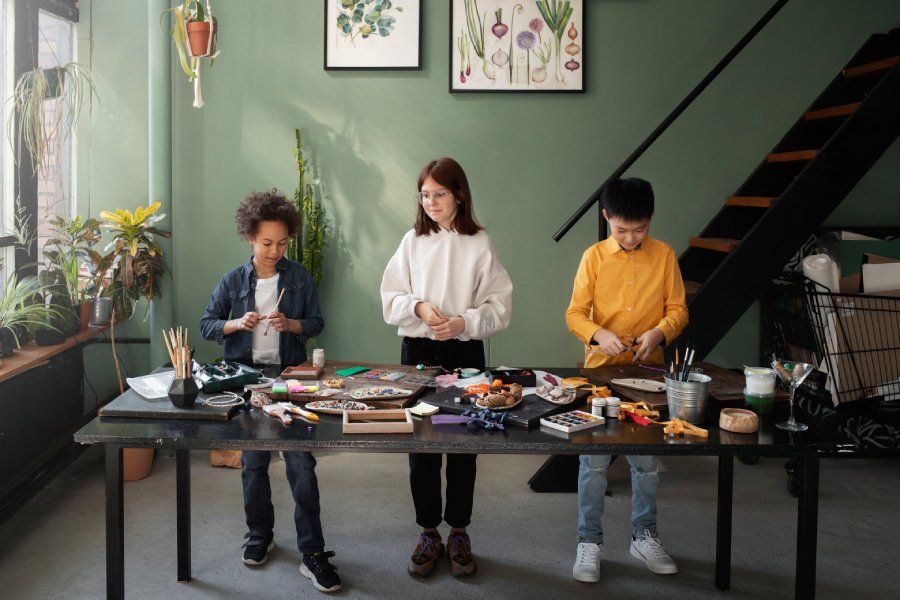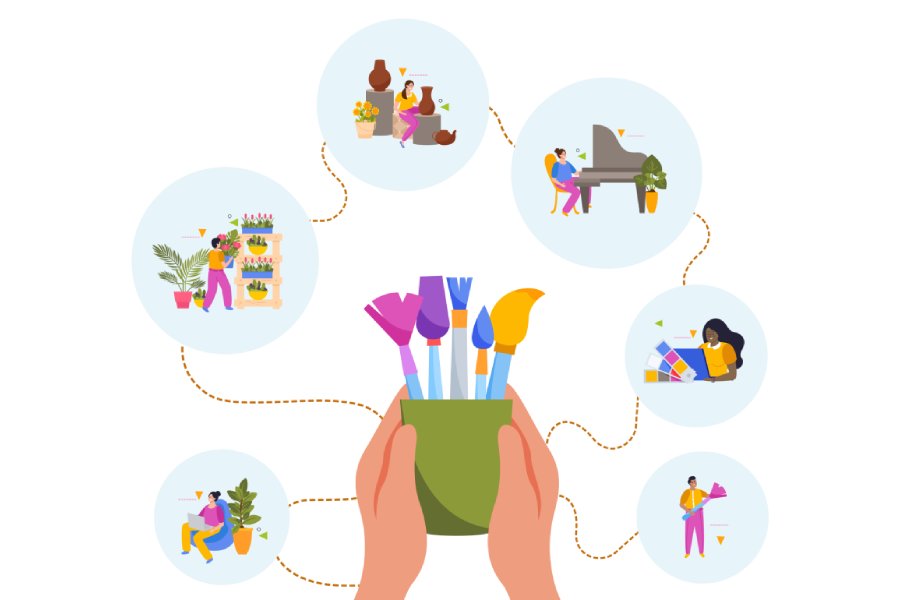Art therapy is a type of mental health support that uses creative activities like art-making to help individuals, families, and communities. It combines art with psychological principles in a therapeutic relationship to improve well-being. Art therapy has always been and will continue to be a multifaceted field. There are many ways in which art can be used for either understanding(assessment) or for helping (therapy); (American Art Therapy Association)
Since prehistoric times the arts have played a crucial role in human history, development, culture, and consciousness. Art for healing is as ancient as the drawings on the walls of caves, but art theory didn’t start to become a formal program until the 1940s (Farokhi M, 2011).
Today, art therapy combines traditional psychotherapeutic theories and techniques with an understanding of the psychological aspects of the creative process, especially the affective properties of the different art materials.
Margaret Naumburg called her approach Dynamically Oriented Art Therapy based primarily on Freudian theory. The dynamic-oriented approach was her main contribution to the art therapy community. This approach promotes ” the release of spontaneous imagery” from the client through the symbols drawn and the free association of the artworks (University of Pennsylvania)
In her introduction to Psychoneurotic Art, she said – “Art therapy is psychoanalytically oriented, recognizing the fundamental importance of the unconscious. Art therapy enables the patient to translate the interior images of his unconscious into pictorial projections; the creation of such symbolic forms establishes a primary basis of communication with the therapist. Spontaneous graphic art becomes a form of symbolic speech that may serve as a substitute for words or as a stimulus that leads to an increase of verbalization in the course of therapy” (Psychoneurotic Art, Galleys, p. 3, Folder 981.)
Art serves as a form of symbolic communication in the context of art psychotherapy. This approach highlights the value of artistic expressions like drawings and paintings as effective tools for conveying emotions, conflicts, and issues. The created art becomes a meaningful means of communication between individuals and therapists, fostering verbal exchange and promoting insight. Through this process, art is seen as a catalyst for resolving conflicts, addressing problems, and generating new perspectives that lead to positive changes, personal growth, and healing. It’s important to note that art therapy and art psychotherapy are often utilized together to varying extents. Essentially, practitioners in this field believe in the dual significance of art as both a therapeutic process and a medium that conveys relevant information in therapy. In essence, art therapy is a transformative process where individuals gain a clearer understanding of themselves by delving into challenging thoughts and emotions through the use of art materials.

How does it work?
Art therapists in India undergo training to identify nonverbal symbols and metaphors expressed during the creative process. These symbols and metaphors can be challenging to articulate through words or other means. The goal is to assist clients in uncovering the underlying thoughts and emotions conveyed in their artwork and understanding its personal significance. This process aims to facilitate insight, discernment, and a deeper understanding of oneself and one’s interpersonal dynamics.
Types of art therapy (Farokhi M , 2011)
Dance Movement Therapy
Dance Therapy uses movement and dance creatively to help a person to further their emotional, cognitive and social integration. This frees the individual to to express human emotion where feelings are expressed, acknowledged and communicated. It is based on the principle that movement reflects the thinking and feeling pattern of the individual and makes meaning on the connection between movement and your emotions.
Drama Therapy
Drama therapy helps with the process of emotional growth through the development of trust, risk taking and experience of different ways of being. The emphasis is not on the performance but on the experience of the group or individual.
Expressive therapy
Supportive-expressive art therapy is an evidence-based, psychodynamic psychotherapy that has been found to be effective in treating certain substance use disorders. The goal is to help clients achieve mastery over their difficulties, gain self understanding and practice self control
Music Therapy
Music therapy is the use of music and sound as a non verbal way of interaction . It offers secure space for expression and development and allows interaction and communication.

Art therapy and the areas it helps in
Art and the creative process can aid many illnesses (cancer, heart disease, influenza, etc.). People can escape the emotional effects of illness through art making and many creative methods. In the field of art therapy for adults, Holmqvist and Persson (2012) overviewed art therapy studies on clients with psychosomatic disorders, eating disorders, or facing crises, based on case studies and intervention techniques. They concluded that there were not enough studies to prove that art therapy is effective for these specific disorders. Similarly, Geue et al. (2010) and a year later, Wood et al. (2011) examined art therapy with cancer patients. They assessed quantitative and qualitative studies and found that most studies have dealt with women suffering from breast cancer. They also documented the intervention techniques that were specifically used with this population, and reported that overall, the quantitative studies reported an improvement in a number of emotional domains faced by these clients. Another article by Huet (2015) reviewed articles dealing with ways to reduce stress in the workplace through art therapy intervention techniques
Conclusion
For millennia, humans have engaged in artistic expression, and the fundamental principle of art therapy asserts that creating art is inherently empowering, healing, and cathartic. Art serves as a medium to convey a spectrum of emotions, including those that individuals may find challenging to verbalize. Through the integration of art into therapeutic interventions, the art therapist aims to encourage patients to share more information and, concurrently, contribute to their overall improvement.
References
Margaret Naumburg papers, Kislak Center for Special Collections, Rare Books and Manuscripts, University of Pennsylvania
Farokhi M. Art therapy in humanistic psychiatry. Procedia – Social and Behavioral Sciences. 2011;30:2088-2092. doi:10.1016/j.sbspro.2011.10.406
Amerian Art Therapy Association “About Art Therapy)
Holmqvist, G., and Persson, C. L. (2012). Is there evidence for the use of art therapy in treatment of psychosomatic disorders, eating disorders and crisis? A comparative study of two different systems for evaluation. Scandinavian J.Psychol. 53, 47–53. doi: 10.1111/j.1467-9450.2011.00923.x
Geue, K., Goetze, H., Buttstaedt, M., Kleinert, E., Richter, D., and Singer, S. (2010). An overview of art therapy interventions for cancer patients and the results of research. Compl. Ther. Med. 18, 160–170. doi: 10.1016/j.ctim.2010.04.001
Wood, M. J., Molassiotis, A., and Payne, S. (2011). What research evidence is there for the use of art therapy in the management of symptoms in adults with cancer? A systematic review. Psychooncology 20, 135–145. doi: 10.1002/pon.1722

